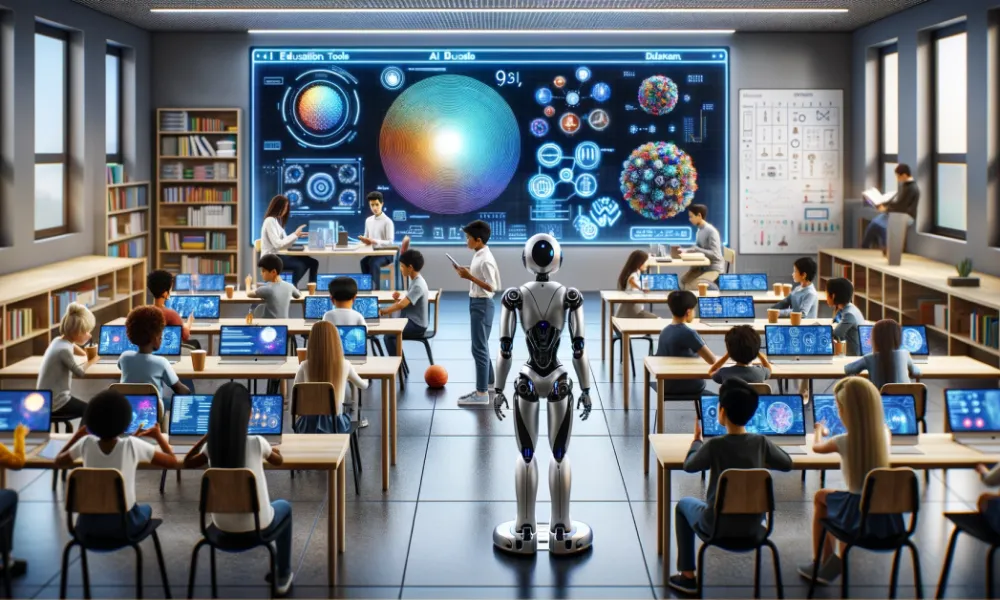

The intersection of artificial intelligence and education is revolutionizing the way we teach and learn. From personalized learning experiences to intelligent tutoring systems, AI is transforming classrooms around the world. (Let’s explore this topic in more detail with 2048 Game below) As we delve into the exciting world of AI in education, we’ll uncover how these smart tools are enhancing student engagement, improving learning outcomes, and preparing the next generation for a technology-driven future.
Artificial intelligence has made significant strides in recent years, and its impact on education has been nothing short of transformative. As schools and universities embrace AI-powered tools, we’re witnessing a shift in traditional teaching methods and learning environments. These smart technologies are not only enhancing the educational experience but also addressing long-standing challenges in the field.
One of the most significant advantages of AI in education is its ability to personalize learning experiences. By analyzing vast amounts of data on student performance, learning styles, and preferences, AI algorithms can tailor educational content and approaches to meet individual needs. This level of customization ensures that each student receives the support and challenges they require to thrive academically.
Intelligent tutoring systems are another prime example of AI’s potential in education. These sophisticated programs use natural language processing and machine learning to provide students with one-on-one guidance, answering questions and offering explanations in real-time. As these systems continue to evolve, they’re becoming increasingly adept at mimicking human tutors, providing students with round-the-clock support and personalized attention.
Read more: Is AI a Threat to Humanity Experts Share Their Views
Traditional assessment methods are being revolutionized by AI technologies, offering more accurate and efficient ways to evaluate student progress. Automated grading systems can now handle a wide range of assignments, from multiple-choice tests to essays, freeing up valuable time for teachers to focus on more complex aspects of education.
Moreover, AI-powered feedback systems provide students with instant, detailed responses to their work. These systems can identify areas of improvement, suggest additional resources, and even predict future performance based on current trends. This immediate feedback loop allows students to make rapid progress and helps teachers identify struggling learners before they fall behind.
As AI continues to advance, we’re seeing the development of more sophisticated assessment tools that can evaluate not just factual knowledge but also higher-order thinking skills, creativity, and problem-solving abilities. These holistic assessment methods provide a more comprehensive picture of student capabilities and help prepare them for the complex challenges of the modern workforce.
Artificial intelligence is also playing a crucial role in boosting student engagement and motivation. Interactive learning platforms powered by AI can adapt to individual learning paces, presenting information in formats that resonate with different learning styles. From gamified learning experiences to virtual reality simulations, these tools make education more immersive and enjoyable.
AI-driven recommendation systems suggest relevant educational content, resources, and activities based on a student’s interests and learning history. This personalized approach not only keeps students engaged but also encourages self-directed learning and curiosity. As students take more control of their educational journey, they develop important skills such as time management, self-motivation, and independent thinking.
Furthermore, AI technologies are enhancing collaboration among students. Intelligent grouping algorithms can form optimal study groups based on complementary skills and learning styles, fostering peer-to-peer learning and teamwork. These collaborative experiences prepare students for the increasingly interconnected and team-oriented nature of modern workplaces.
While AI is not replacing human teachers, it is becoming an invaluable assistant in the classroom. Intelligent systems can handle routine administrative tasks, such as scheduling, record-keeping, and basic communication with students and parents. This automation frees up teachers to focus on what they do best: providing personalized instruction, mentorship, and emotional support to their students.
AI-powered tools are also assisting teachers in creating more effective lesson plans and instructional materials. By analyzing vast educational databases and student performance data, these systems can suggest optimal teaching strategies, identify potential learning obstacles, and recommend resources that align with curriculum goals and student needs.
Additionally, AI is enhancing professional development for educators. Personalized training programs use AI to identify areas where teachers can improve their skills and provide targeted resources and feedback. This continuous learning approach ensures that educators stay up-to-date with the latest pedagogical techniques and technological advancements.
One of the most promising aspects of AI in education is its potential to address longstanding inequalities in access to quality education. Intelligent tutoring systems and adaptive learning platforms can provide personalized support to students in underserved communities, helping to bridge the achievement gap.
AI-powered language translation tools are breaking down language barriers in education, allowing students from diverse linguistic backgrounds to access high-quality educational content in their native languages. This technology is particularly beneficial for immigrant students and those in multilingual environments.
Furthermore, AI is playing a crucial role in identifying and supporting students with special educational needs. Advanced diagnostic tools can detect learning disabilities and other challenges early on, allowing for timely interventions and personalized support strategies. This early identification and tailored assistance can significantly improve outcomes for students who might otherwise struggle in traditional educational settings.
As AI continues to reshape industries and job markets, it’s crucial that education systems adapt to prepare students for this new reality. Many schools are now incorporating AI literacy into their curricula, teaching students not just how to use AI tools but also how to understand their implications and limitations.
Courses in data science, machine learning, and AI ethics are becoming increasingly common in high schools and universities. These programs aim to equip students with the skills and knowledge they’ll need to thrive in an AI-driven economy, whether they pursue careers in technology or other fields impacted by AI.
Moreover, the integration of AI in education is fostering important soft skills that will be crucial in the future job market. As routine tasks become increasingly automated, skills such as critical thinking, creativity, emotional intelligence, and adaptability are becoming more valuable. AI-enhanced educational experiences are designed to cultivate these skills, preparing students for a world where human-AI collaboration is the norm.
While the potential of AI in education is immense, it’s important to address the ethical considerations and challenges that come with its implementation. Data privacy is a major concern, as AI systems rely on vast amounts of student data to function effectively. Ensuring the security and ethical use of this data is paramount to maintain trust in AI-powered educational tools.
There’s also the risk of algorithmic bias in AI systems, which could perpetuate or exacerbate existing inequalities in education. It’s crucial that AI tools are developed and implemented with diversity and inclusivity in mind, and that they are regularly audited for fairness and accuracy.
Another challenge is the potential overreliance on AI technologies. While these tools can greatly enhance the educational experience, they should not replace human interaction and mentorship. Striking the right balance between AI-assisted learning and traditional teaching methods is essential to ensure a well-rounded education.
The digital divide also presents a significant challenge to the equitable implementation of AI in education. Efforts must be made to ensure that students from all socioeconomic backgrounds have access to these advanced technologies to prevent further widening of educational disparities.
Read more: How to Use AI to Make Money Online
Looking ahead, the future of AI in education is filled with exciting possibilities. We can expect to see even more sophisticated personalized learning experiences, powered by advanced machine learning algorithms and neural networks. These systems will be capable of adapting not just to a student’s academic needs but also to their emotional state and learning preferences in real-time.
Virtual and augmented reality technologies, enhanced by AI, will create immersive learning environments that bring abstract concepts to life. Students might explore historical events in VR, conduct virtual science experiments, or practice language skills with AI-powered virtual conversation partners.
AI will also play a crucial role in lifelong learning and reskilling initiatives. As the job market continues to evolve rapidly, AI-powered platforms will help adults acquire new skills and knowledge throughout their careers, offering personalized learning pathways based on their professional goals and existing skill sets.
Furthermore, we can anticipate the development of more advanced AI teaching assistants that can handle complex queries and provide nuanced explanations across a wide range of subjects. These AI assistants might work alongside human teachers, offering additional support and insights to enhance the learning experience.
The integration of AI with other emerging technologies, such as the Internet of Things (IoT) and blockchain, will create new possibilities for tracking and verifying educational achievements. Smart classrooms equipped with IoT sensors and AI analytics will provide real-time feedback on student engagement and comprehension, allowing for immediate adjustments to teaching strategies.
The integration of AI in education represents a paradigm shift in how we approach teaching and learning. From personalized learning experiences to intelligent tutoring systems, AI is reshaping classrooms and educational institutions around the world. While challenges remain, particularly in terms of ethics and equitable access, the potential benefits of AI in education are immense.
As we move forward, it’s crucial that educators, policymakers, and technology developers work together to harness the power of AI responsibly and effectively.